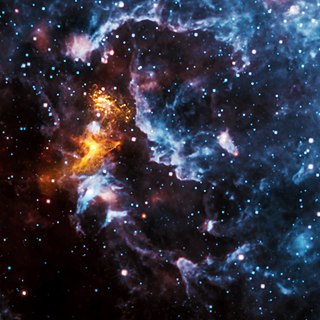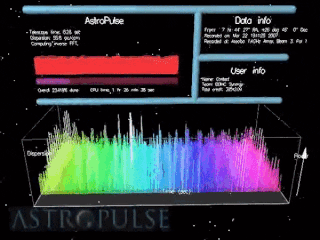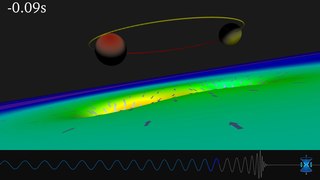Related Research Articles
Rader's algorithm (1968), named for Charles M. Rader of MIT Lincoln Laboratory, is a fast Fourier transform (FFT) algorithm that computes the discrete Fourier transform (DFT) of prime sizes by re-expressing the DFT as a cyclic convolution.
The Fourier transform of a function of time, s(t), is a complex-valued function of frequency, S(f), often referred to as a frequency spectrum. Any linear time-invariant operation on s(t) produces a new spectrum of the form H(f)•S(f), which changes the relative magnitudes and/or angles (phase) of the non-zero values of S(f). Any other type of operation creates new frequency components that may be referred to as spectral leakage in the broadest sense. Sampling, for instance, produces leakage, which we call aliases of the original spectral component. For Fourier transform purposes, sampling is modeled as a product between s(t) and a Dirac comb function. The spectrum of a product is the convolution between S(f) and another function, which inevitably creates the new frequency components. But the term 'leakage' usually refers to the effect of windowing, which is the product of s(t) with a different kind of function, the window function. Window functions happen to have finite duration, but that is not necessary to create leakage. Multiplication by a time-variant function is sufficient.
An astronomical radio source is an object in outer space that emits strong radio waves. Radio emission comes from a wide variety of sources. Such objects are among the most extreme and energetic physical processes in the universe.

Einstein@Home is a volunteer computing project that searches for signals from spinning neutron stars in data from gravitational-wave detectors, from large radio telescopes, and from a gamma-ray telescope. Neutron stars are detected by their pulsed radio and gamma-ray emission as radio and/or gamma-ray pulsars. They also might be observable as continuous gravitational wave sources if they are rapidly spinning and non-axisymmetrically deformed. The project was officially launched on 19 February 2005 as part of the American Physical Society's contribution to the World Year of Physics 2005 event.

A pulsar is a highly magnetized rotating neutron star that emits beams of electromagnetic radiation out of its magnetic poles. This radiation can be observed only when a beam of emission is pointing toward Earth, and is responsible for the pulsed appearance of emission. Neutron stars are very dense and have short, regular rotational periods. This produces a very precise interval between pulses that ranges from milliseconds to seconds for an individual pulsar. Pulsars are one of the candidates for the source of ultra-high-energy cosmic rays.

The Crab Pulsar is a relatively young neutron star. The star is the central star in the Crab Nebula, a remnant of the supernova SN 1054, which was widely observed on Earth in the year 1054. Discovered in 1968, the pulsar was the first to be connected with a supernova remnant.
Beamforming or spatial filtering is a signal processing technique used in sensor arrays for directional signal transmission or reception. This is achieved by combining elements in an antenna array in such a way that signals at particular angles experience constructive interference while others experience destructive interference. Beamforming can be used at both the transmitting and receiving ends in order to achieve spatial selectivity. The improvement compared with omnidirectional reception/transmission is known as the directivity of the array.
A low-probability-of-intercept radar (LPIR) is a radar employing measures to avoid detection by passive radar detection equipment while it is searching for a target or engaged in target tracking. This characteristic is desirable in a radar because it allows finding and tracking an opponent without alerting them to the radar's presence. This also protects the radar installation from anti-radiation missiles (ARMs).

Geminga is a gamma ray and x-ray pulsar source thought to be a neutron star approximately 250 parsecs from the Sun in the constellation Gemini.
A pitch detection algorithm (PDA) is an algorithm designed to estimate the pitch or fundamental frequency of a quasiperiodic or oscillating signal, usually a digital recording of speech or a musical note or tone. This can be done in the time domain, the frequency domain, or both.
The Goertzel algorithm is a technique in digital signal processing (DSP) for efficient evaluation of the individual terms of the discrete Fourier transform (DFT). It is useful in certain practical applications, such as recognition of dual-tone multi-frequency signaling (DTMF) tones produced by the push buttons of the keypad of a traditional analog telephone. The algorithm was first described by Gerald Goertzel in 1958.

Astropulse is a volunteer computing project to search for primordial black holes, pulsars, and extraterrestrial intelligence (ETI). Volunteer resources are harnessed through Berkeley Open Infrastructure for Network Computing (BOINC) platform. In 1999, the Space Sciences Laboratory launched SETI@home, which would rely on massively parallel computation on desktop computers scattered around the world. SETI@home utilizes recorded data from the Arecibo radio telescope and searches for narrow-bandwidth radio signals from space, signifying the presence of extraterrestrial technology. It was soon recognized that this same data might be scoured for other signals of value to the astronomy and physics community.

Neutron detection is the effective detection of neutrons entering a well-positioned detector. There are two key aspects to effective neutron detection: hardware and software. Detection hardware refers to the kind of neutron detector used and to the electronics used in the detection setup. Further, the hardware setup also defines key experimental parameters, such as source-detector distance, solid angle and detector shielding. Detection software consists of analysis tools that perform tasks such as graphical analysis to measure the number and energies of neutrons striking the detector.
Rotating radio transients (RRATs) are sources of short, moderately bright, radio pulses, which were first discovered in 2006. RRATs are thought to be pulsars, i.e. rotating magnetised neutron stars which emit more sporadically and/or with higher pulse-to-pulse variability than the bulk of the known pulsars. The working definition of what a RRAT is, is a pulsar which is more easily discoverable in a search for bright single pulses, as opposed to in Fourier domain searches so that 'RRAT' is little more than a label and does not represent a distinct class of objects from pulsars. As of March 2015 over 100 have been reported.

Gravitational waves are waves of the intensity of gravity that are generated by the accelerated masses of binary stars and other motions of gravitating masses, and propagate as waves outward from their source at the speed of light. They were first proposed by Oliver Heaviside in 1893 and then later by Henri Poincaré in 1905 as the gravitational equivalent of electromagnetic waves.

PSR B1937+21 is a pulsar located in the constellation Vulpecula a few degrees in the sky away from the first discovered pulsar, PSR B1919+21. The name PSR B1937+21 is derived from the word "pulsar" and the declination and right ascension at which it is located, with the "B" indicating that the coordinates are for the 1950.0 epoch. PSR B1937+21 was discovered in 1982 by Don Backer, Shri Kulkarni, Carl Heiles, Michael Davis, and Miller Goss.
A pulsar timing array (PTA) is a set of galactic pulsars that is monitored and analysed to search for correlated signatures in the pulse arrival times on Earth. As such, they are galactic-sized detectors. Although there are many applications for pulsar timing arrays, the best known is the use of an array of millisecond pulsars to detect and analyse long-wavelength gravitational wave background. Such a detection would entail a detailed measurement of a gravitational wave (GW) signature, like the GW-induced quadrupolar correlation between arrival times of pulses emitted by different millisecond pulsar pairings that depends only on the pairings' angular separations in the sky. Larger arrays may be better for GW detection because the quadrupolar spatial correlations induced by GWs can be better sampled by many more pulsar pairings. With such a GW detection, millisecond pulsar timing arrays would open a new low-frequency window in gravitational-wave astronomy to peer into potential ancient astrophysical sources and early Universe processes, inaccessible by any other means.
Single-molecule fluorescence resonance energy transfer is a biophysical technique used to measure distances at the 1-10 nanometer scale in single molecules, typically biomolecules. It is an application of FRET wherein a pair of donor and acceptor fluorophores are excited and detected at a single molecule level. In contrast to "ensemble FRET" which provides the FRET signal of a high number of molecules, single-molecule FRET is able to resolve the FRET signal of each individual molecule. The variation of the smFRET signal is useful to reveal kinetic information that an ensemble measurement cannot provide, especially when the system is under equilibrium with no ensemble/bulk signal change. Heterogeneity among different molecules can also be observed. This method has been applied in many measurements of intramolecular dynamics such as DNA/RNA/protein folding/unfolding and other conformational changes, and intermolecular dynamics such as reaction, binding, adsorption, and desorption that are particularly useful in chemical sensing, bioassays, and biosensing.
Pulse-Doppler signal processing is a radar and CEUS performance enhancement strategy that allows small high-speed objects to be detected in close proximity to large slow moving objects. Detection improvements on the order of 1,000,000:1 are common. Small fast moving objects can be identified close to terrain, near the sea surface, and inside storms.
David Hudson Staelin was an American astronomer, engineer, and entrepreneur. He co-discovered the Crab nebula pulsar in 1968, and was Principal Investigator for earth-remote-sensing satellite instruments. He was a co-founder of Environmental Research and Technology, Inc. and the founding chairman of PictureTel Corp., one of the first videoconferencing firms.
References
- 1 2 3 4 5 Parent, E.; Kaspi, V. M.; Ransom, S. M.; Krasteva, M.; Patel, C.; Scholz, P.; Brazier, A.; McLaughlin, M. A.; Boyce, M.; Zhu, W. W.; Pleunis, Z.; Allen, B.; Bogdanov, S.; Caballero, K.; Camilo, F. (2018-06-29). "The Implementation of a Fast-folding Pipeline for Long-period Pulsar Searching in the PALFA Survey". The Astrophysical Journal. 861 (1): 44. arXiv: 1805.08247 . doi: 10.3847/1538-4357/aac5f0 . ISSN 1538-4357.
- 1 2 Staelin, David H. (1969), "Fast Folding Algorithm for Detection of Periodic Pulse Trains", Proceedings of the IEEE, 57 (4): 724–5, Bibcode:1969IEEEP..57..724S, doi:10.1109/PROC.1969.7051
- ↑ "BLIPSS". GitHub .